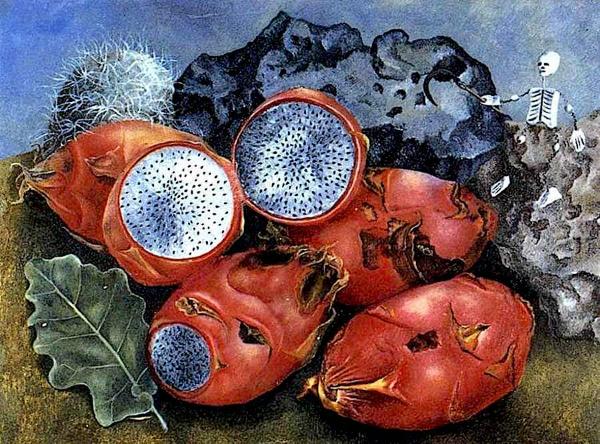
Frida Kahlo’s works are a journey into her soul and her story, strewn with philosophical and personal references, projections of her feelings and her most intimate memories, while exploring her obsession with the notion of “death”. fertilize life”.
The title of the work is taken directly “from the five large pitahayas gathered in the center of the composition. Originally from Central America, the pitahaya is the shiny red-skinned fruit produced by the cactus of the same name. The fruit measures almost 10 cm. Its fleshy grayish-white heart is dotted with black pips. Despite the presence of brown spots on their skin, these pitahayas are not spoiled. When the skin of the fruit begins to turn brown, it means it is ripe and ready to eat.”
At first glance, the still life produced by Frida Kahlo looks like a simple arrangement of plants and vegetation from her studio and her home. But on closer inspection, the painting is more of a self-portrait than a still life.
Mother’s wounds:
At Frida Kahlo, plants symbolize fertility and regeneration.
Especially here, where the pitahaya, cut in half, evokes a female reproductive cell (an ovum) having been dissected. This egg is in the phase of cell division, called meiosis. One of the main factors of miscarriage in women is due to errors that have occurred during this process. The artist suffered several miscarriages during her life. The subject alludes to it.
The secret and botanical garden:
In Mexico City, Frida Kahlo cultivated and maintained an exquisite garden around Casa Azul, the mansion that served as her residence and studio. This garden produced pitahayas and was dotted with “old man’s head” cacti (covered in fluffy white hairs). Several of his paintings include these particular cacti, suggesting that his garden was an extension of his artistic practice.
Roots” :
On the ground, we see a young immature leaf of philodendron. This plant grew in his family’s garden. Frida Kahlo was interested in the origins of her family: her father was German and Hungarian, her mother was Mexican. The artist painted philodendrons in other paintings that highlighted his mixed genetic heritage.
Volcanoes, source of inspiration:
At the time this painting was painted, the area south of Mexico City was a vast expanse of volcanic rock. This lava field, called El Pedregal, has attracted many artists, including Frida Kahlo and her husband Diego Rivera, because of its mythical significance as a prehistoric site. In this still life, the artist painted part of the volcanic rocks that adorned his garden. The rough outline of rock against a backdrop of blue sky evokes the mountainous skyline of Mexico City.
Vanity:
A small clay skeleton, jointed with springs, is perched on a brown volcanic rock. He wields a scythe, often associated with the image of the Grim Reaper, which personifies death. The mischievous representation of this skeleton is a discreet reminder of the inevitability of death. Everything matures, then inevitably ends up decomposing. We must therefore enjoy life while there is still time. In 1939, on her return from France, she learned that Diego wanted a divorce. Frida then changes the expression of the skeleton in the painting, which goes from a smile to a scowl.



